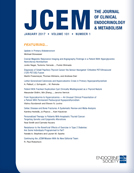-
Views
-
Cite
Cite
RICHARD V. CLARK, BARRY D. ALBERTSON, ABRAHAM MUNABI, FERNANDO CASSORLA, GRETI AGUILERA, DWIGHT W. WARREN, RICHARD J. SHERINS, D. LYNN LORIAUX, Steroidogenic Enzyme Activities, Morphology, and Receptor Studies of a Testicular Adrenal Rest in a Patient with Congenital Adrenal Hyperplasia, The Journal of Clinical Endocrinology & Metabolism, Volume 70, Issue 5, 1 May 1990, Pages 1408–1413, https://doi.org/10.1210/jcem-70-5-1408
Close - Share Icon Share
Abstract
Steroid-secreting tumors of the testis have generally been considered to be of Leydig cell origin. Testicular tumors in patients with congenital adrenal hyperplasia have been thought to be adrenal rests, but no conclusive evidence supporting the hypothesis has been presented. We report a morphological and biochemical analysis of a patient with 21-hydroxylase deficiency who developed bilateral nodular hyperplasia of steroid-secreting tissue within the testis, despite suppression therapy with both exogenous glucocorticoids and testosterone. The tissue was formed of confluent nodules of homogenous cells. Electron microscopy showed the cells to have abundant smooth endoplasmic reticulum, well developed Golgi apparatus, and mitochondria with predominantly tubular cris-tae, features characteristic of steroid-secreting cells of adreno-cortical origin. Crystals of Reinke were not observed. Functional studies in vivo showed a marked response to ACTH infusion, with 17-hydroxyprogesterone rising from 56 to 13,500 ng/mL, cortisol from less than 2 to 19 μg/dh, and testosterone from 369 to 629 ng/dL, with an attendant increase in testicular size and pain over 48 h. Receptor studies in vitro revealed no gonadotropin receptors, but abundant angiotensin-II receptors. Enzyme activity analysis in vitro showed undetectable 21-hydroxylase activity and an enzyme profile consistent with adrenocortical cells rather than Leydig cells. Based on these morphological and biochemical findings, we conclude that the nodular steroidogenic tissue that replaced this patient's testes was of adrenal origin. The study documents for the first time the development of adrenocortical tumors from adrenal rest tissue within the testis.





